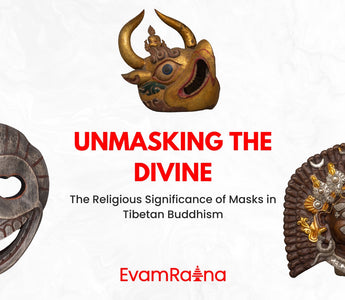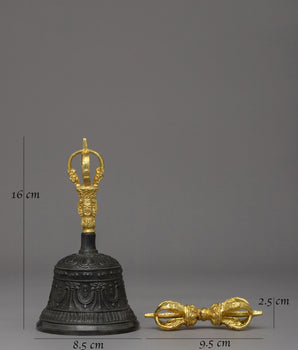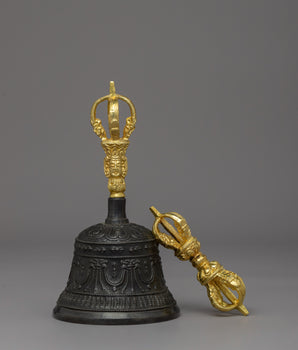Masks in Tibetan Buddhism: Sacred Symbols of Transformation and Protection
Tibetan Buddhism's masks are not simply decorative adornments or costume pieces, but sacred, spiritual objects. No matter how brightly painted, they are nonetheless a prerequisite to the transition from human to deity. Most frequently, these symbolic coverings might be worn in Cham dances or ceremonial rites, at which point the masked face engages well outside of human identity. When "the human" is replaced by the mask of a meditational deity such as Mahakala or Padmasambhava, that identity becomes an archetypical form that channels actual energy in the blessing, protecting, or purifying of the world around them. Once we recognize this distinction, we are immediately confronted with a Tibetan Buddhist understanding of reality, in that form cannot be separated from function, or put another way, external symbolism referring to the inner awakening.
In exploring masks in Tibetan Buddhism, it is necessary to discuss a complex convergence of Buddhist philosophy, shamanistic models of interaction, and the indigenous Bon religion of Tibet. Basically, these visages are the material manifestations of complex cosmological constructs, or representations of forces as they relate to civilization. Masks do allude to a specific iconography, or purpose that ranges from peaceful deities to wrathful protectors, with resonance in both monastic traditions and localized mythologies. In order to appreciate the richness of these iconic portrayals, we need to specifically examine the types of masks used within Tibetan Buddhism specifically, and its continuing symbolic roles in sacred and social life.
The Historical Roots of Tibetan Masks
Origins and Evolution
The origins of mask usage in Tibetan Buddhism can be traced back to the ancient Bon religion, the indigenous spiritual tradition of Tibet that predated Buddhism. In Bon ceremonies, masks were used in shamanic rituals, often symbolizing animals or nature spirits. These masks embodied the forces of nature and were worn to communicate with the spirit world, ward off malevolent forces, or bring blessings to the people.

When Buddhism spread to Tibet around the 7th century, it gradually absorbed many Bon elements, and the use of masks became an integral part of Buddhist rituals. As Buddhism took root and evolved within the Tibetan cultural context, the purpose and design of these echoes of the sacred shifted. They began to represent not just spirits or natural forces but highly developed deities from the Buddhist pantheon, as well as mythological figures, historical saints, and cosmic principles. This syncretism gave birth to a unique form of spiritual expression that continues to this day.
Cultural Significance
Masks became particularly vital to Tantric Buddhism, where visual symbolism and ritual performance are part of the practice. The mask became a sacred object, capable of removing the physical self, and embodying the qualities of the divine being. They acted as both educational tools, as well as ritual objects. Both monks and lay practitioners would gather to see masked performative events during significant religious festivals. This also created moments for worship, communal learning, and communal purification.
Over several generations, mask-making artisans emerged, and monastic traditions began to codify the styles, roles, and symbolic systems underpinning each mask utilized for the performative event. This meant that the sacred meanings of the individual masks adhered to, and were honored across hundreds of years..
The Cham Dance: A Sacred Performance
Ritualistic Importance
An excellent illustration of how the act of using masks is expressed in Tibetan Buddhism is the Cham dance. Cham dance is sacred; it is not a performance in the entertainment sense, but a ritual in motion, a spiritual offering to promote peace and auspiciousness. It is done by monks at major religious festivals, such as Monlam Chenmo (Great Prayer Festival) or Losar (Tibetan New Year), which are some of the most important dates on the Tibetan calendar.

Monks performing Cham Dance Featuring Various Wooden Masks
(Photo from Wikimedia Commons)
Before the Cham dance, the monks go through a rigorous preparation phase that can include prayers, meditation, fasting, and possibly days of retreat. The preparation has the aim to clear the mind and connect the dancer with the spiritual sensitivity of the deity they have projected. When the dance finally takes place, each monk dons a mask and costume that has been chosen for him. Music for the event is made with traditional instruments (long horns, conch shells, bone trumpets and drums) that define the rhythm for the drama to unfold.
The movements of the Cham dance are not arbitrary; they have an interpretive significance. Every step, spin, and gesture performed embodies the mythological battles between good and evil, life and death, and the soul's journey toward awakening. Audiences respond to the immediacy and precision of the performance, believing it brings blessings, disperses negative energies, and channels the path toward enlightenment.
Symbolism and Purpose
Every mask in a Cham dance has a story. A red face may denote wrathful compassion, a deity that resolutely defends dharma by destroying ignorance. A white face possibly signifies peacefulness and divine wisdom. A wrathful protector deity mask, like Mahakala or Palden Lhamo, is clearly meant to be terrifying; bulging eyes, gnashing teeth, and crowned with skulls, a disgraceful and shocking spirit. But these demonic visages should not instill fear of dharma or be praised for their ferocity, but rather represent the enlightened being's ability to destroy negative internal demons (like greed, hatred, ignorance, and desire).
When the monks wear these masks, they open themselves to putting aside their human being, becoming sacred again. The monks are provided a connection to their own being and to the audience in a direct physical, visceral way. Thus, the Cham dance is not only a gift to the deities, but at the same time, a teaching moment to all who witness it, a moment to collapse distinctions of performer and watcher, sacred and secular.
Crafting the Sacred: The Art of Mask Making
Materials and Techniques
In a Tibetan Buddhist community, creating a mask requires spiritual circumstantial work balanced against traditional artisanship. Traditionally, the process begins with a rough sketch, even a clay mold, with layers of cloth dipped in a mixture of barley flour glue (tsampa) and brine covering the mold. This allows finished masks to be light and durable masks made for permanent display and dance.
Each level must completely dry before another is applied and this whole affair can take weeks. After the mask has formed and the clay mold has been removed, the mask is then painted. Traditionally, natural pigments were used: ground minerals for reds and yellows, charcoal for black, and crushed shell for white. Nowadays, depending upon availability of pigments and context, both traditional and modern paints are used.

Hair adds another level of detail and this included yak hair from yaks that are raised for this purpose and of a special kind for sacred masks. The use of gold leaf, turquoise, coral, and sometimes small ritual objects may be inlaid in some ceremonial masks particularly those made for high level rituals or as cosmetic adornment for temples.
Spiritual Guidelines
Making a mask is not simply a matter of looks—it's a meditative and sacred task. The mask-maker is required to follow certain iconographic regulations established in Buddhist texts and thangka painting manuals. Every angle, every proportion, and every color has symbolic meaning, as well as spiritual purpose. For example, wrathful deities require glaring eyes and protruding fangs to accurately portray their role as fierce protectors; peaceful deities should have serene expressions and soft features.
Frequently, while artisans create masks, they will chant mantras, imparting spiritual energy to the mask. There are even traditions in which monasteries complete a consecration for masks before being worn in dance or before being placed in a shrine. Hence, each mask is more than a mere object--it is a living presence of the divine.
Understanding the Symbolism: Why Different Masks Exist
Masks in Tibetan Buddhism can be as varied as the spiritual functions they embody. Each mask is more than a visual display—it is both sacred and a complex manifestation of theological principles, cosmological understandings, and regional customs. Whether donned by monastic dancers in elaborate Cham rituals or used by rural villagers in local celebrations, masks denote people— calm Buddhas, ferocious protectors, ancestors, and wild demon spirits. This variety exemplifies both the richness of the Tibetan Buddhist pantheon and the multilayered fabric of Tibetan society, where high monastic philosophy, folk religion, and ancient shamanic traditions are woven together. Knowing the types of masks is essential to understanding how Tibetan Buddhism symbolically expresses its core tenets and rituals and, importantly, how it engages practitioners in a symbolic and communal place. In his article, Demons and Deities Masks of the Himalayas, Thomas Murray broadly categorises these masks as follows:
Classical Masks

Click Here To View Our Authentic Mahakala Mask
The classical mask is the most recognizable of Buddhist ceremonials and typically represents a deity from the Tibetan Buddhist pantheon, such as Padmasambhava (Guru Rinpoche), Avalokiteshvara, Vajrapani, or the wrathful protector Mahakala. The use of these faces is ceremonial (monastic only) and governed by rules of consecration and ritual use.
These masks are highly stylized and while not in use they are often kept within temples. The attributes of the deity - compassion, wisdom, wrathful protector, and enlightened power - are conveyed through the characteristics and colors of the mask. Monks wearing these visages invite the energy of the associated deities during important ceremonies.
Village Masks

Village masks are a less formal and more locally based culture. They are made by lay people and many village artisans, and they often represent characters from folk stories, demons, animals, or ancestral spirits. The community will wear them at festivals or harvest celebrations where the backgrounds of Buddhism, together with the local stories and customs, meld into the mask.
Although not as formal as their classical counterparts, they have an important cultural role to play. They inherently carry traditions of motivating ethical behavior, important legends/stories, and community values. In many villages, the masked drama serves both as entertainment and a method of providing moral guidelines to younger generations.
Shamanic Masks

Traditional Shaman Mask
(Photo From Himalayan Art Resource)
Shaman masks represent ancient Bon traditions and pre-Buddhist spiritual practices. Shaman disguises are typically wooden and more utilitarian in appearance. They are often used in rituals for healing/mending, the intercession of spirits, or nature worship.
Shaman masks are worn by shamans or lay practitioners, and they are thought to protect within trance states in order to help the wearer navigate through the spirit world safely. In contemporary culture it is less common for use in Buddhism, but are still used among more isolated or rural locations that preserve older traditions.
The Role of Masks in Spiritual Transformation
Embodiment of Deities
One of the most significant elements of mask use in Tibetan Buddhism is the notion that when wearing the mask, the practitioner is a manifestation of the deity. The practitioner is not simply acting; instead, they are practicing a spiritual activity that enables them to transcend ego and merge with divine consciousness. The mask becomes a literal means of transformation, since the wearer becomes an enlightened being, able to pass on blessings and wisdom.
This notion conforms nicely to important ideas in Tibetan Buddhism, especially key tantric ideas, such as "deity yoga," which is a practice in which a practitioner visualizes themselves as a deity with the aim of cultivating its qualities. The mask becomes a tangible form of this visualization, permitting the practitioner to externalize and realize the becoming.
Protection and Purification
Masks also play a powerful protective role for both individual and collective purposes. The wrathful deity masks, for example, are said to scare away evil spirits, negative energy, and worries. During ceremonial dances or exorcisms the monk, while wearing a mask representing a wrathful aspect, destroys obstacles standing in the way for spiritual bestowing wisdom and peace.
In ceremonies, not only are the faces of the divine present, but they are also joined by sacred music and chants often associated with purification. As the purification takes place, it is common for the physical power of these visages to help clear and ensure that not only is the space physically cleared but the minds and hearts of the participants are also purified. Thus, it is reasonable to assume sacred masks are used to aid in acknowledgment of spiritual objectives in maintaining a balance, harmony, and sanctity in the world.
Contemporary Relevance and Preservation
Cultural Heritage
As modernization and turmoil occur, the preservation of the Tibetan mask traditions has taken on renewed urgency. Today, the majority of monasteries and cultural organizations in Tibet and in India and Nepal are hosting workshops and festivals for the purpose of introducing traditional formats of mask-making and Cham performance to young monks and artists.
This is critical in helping maintain knowledge of these traditional forms for future generations. More than ever, there are documentaries, academic projects, and art exhibitions devoted to raising awareness regarding the cultural and spiritual meaning of Tibetan masks that build pride for those within the Tibetan community and interest from a global audience.
Global Influence
Tibetan masks have curious followers throughout the globe, appearing not only within spiritual à la modes but also amongst artists, anthropologists, and avid collectors. Major museum exhibitions such as the Rubin Museum of Art in New York City or the National Museum of Asian Art in Washington, D.C., have helped develop broader audiences for these sacred objects, but contemporary Buddhist communities around the world have incorporated masked rituals and dances into their practices.
This global interest contributes to an increasing visibility of Tibetan heritage traditions, yet this can require caution with our interpretations. While it is acceptable for masks in modern contexts, the masks should not lose the sense of context, or exoticism rather than sacredness. In order to give meaning and context to the innovative masks, we must respect their sacred function and cultural origins, which will maintain their place as a source of wisdom and inspiration for generations to come.
Conclusion
Tibetan Buddhist masks are not just elaborate works of art; they embody the spiritual power, transformation, and protection of their wearer. The ritual performance of Cham dances rolls together ancient Tibetan Bon practices with this idea of transformation by human figures becoming manifestations of enlightened beings, creating an embodiment of their qualities. In addition to personal transformation, masks in conjunction with the ritual performance of Cham dances serve for purification of the space and communities, celebration of heritage, and connection to timeless teachings.
The growing appreciation for Tibetan culture, in part, necessitates the preservation of the art and traditions of mask-making through respectful cultivation of the worsening stigmas of globalization, whilst failing to eradicate the powerful monastic ethos. Sacred mask forms create waves or networked resonances that highlight the awareness of transformation, and that awakening is always possible just beyond the masks they wear. Whether in the mountains of Tibet, the monastic practices of India, or on display in cultural museums across the world, the sacred mask forms remind us that they offer the possibility for transformation rests just behind the masks on our faces.
Click Here To View Our Collection Of Tibetan Masks











